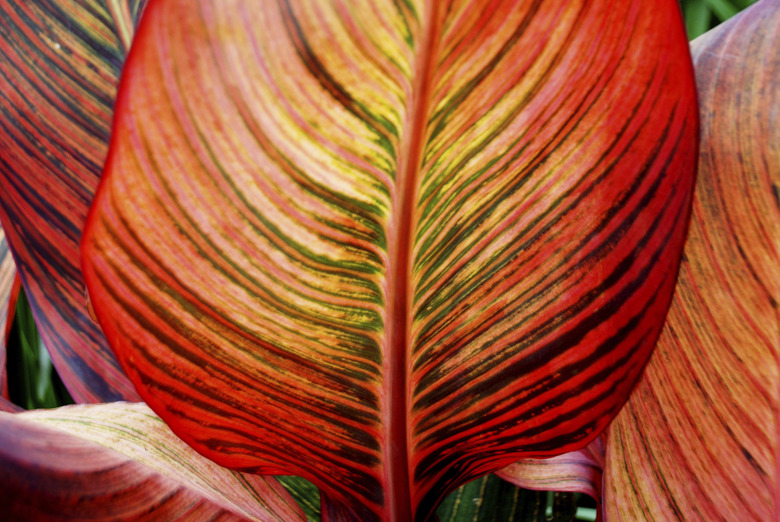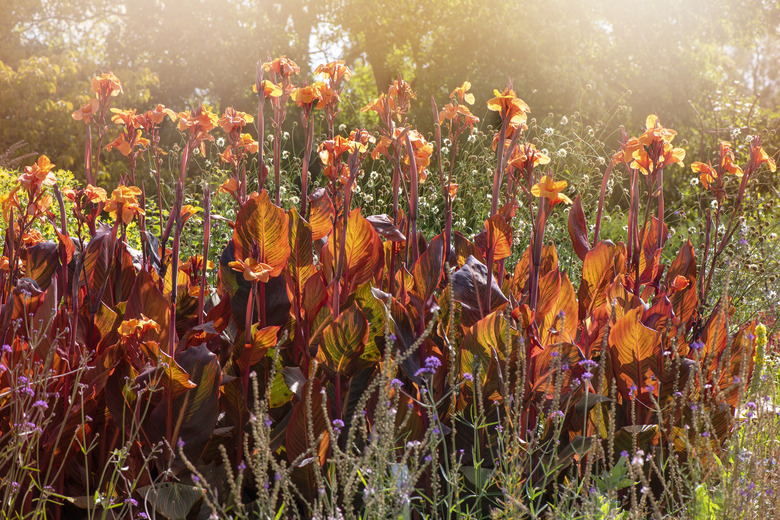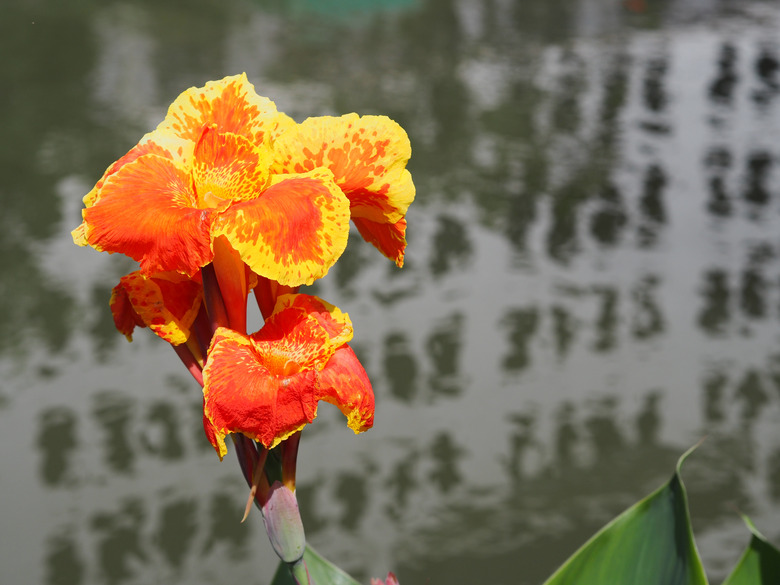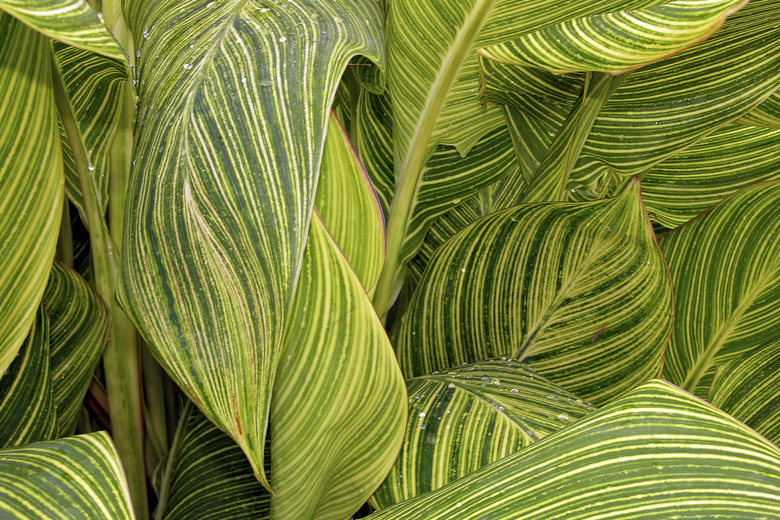How To Care For Tropicanna® Canna Lilies
Caring for a Tropicanna® canna lily (Canna 'Phasion' Tropicanna®) takes a moderate amount of effort but will reward you with a year-round display of brilliantly colored foliage and showy orange flowers. This sensitive tropical grows best in USDA plant hardiness zones 7 to 11, although it can be grown in climates colder than zone 7 if the rhizome is lifted and overwintered indoors.
Watering, feeding and pruning all factor into successfully caring for Tropicanna® cannas at home, but they can also occasionally develop minor problems that must be addressed to keep them healthy and blooming.
Basic Care for Tropicanna® Canna Lilies
The basics of canna plant care are simple and will make a difference when growing a Tropicanna® canna plant at home.
Watering a Tropicanna® Canna
Tropicanna® cannas need plenty of water, but too much moisture in the soil can cause problems.
- Water only when the soil feels dry on the surface.
- Provide 1 inch of water each week during the growing season.
- Check the soil moisture often between waterings—cannas growing in sandy soil need more frequent watering while those in clay soil need less frequent watering.
Feeding a Tropicanna® Canna
No fertilizer is necessary if your Tropicanna® canna is growing in fertile soil. Otherwise, two fertilizer applications during the growing season are needed to support the plant's growth and flowering.
- Feed with balanced granular fertilizer such as 10-10-10 or use an organic option such as fish emulsion.
- Apply fertilizer in early spring and again in midsummer.
- Apply the fertilizer carefully so that it doesn't get on the foliage.
- Water well after feeding to distribute the fertilizer among the roots.
Overwintering a Tropicanna® Canna
In climates colder than USDA zone 7, Tropicanna® cannas must be dug up and the rhizomes overwintered indoors until the following spring.
Lifting Canna Rhizomes
1. Cut back the canna foliage to the base using sharp, clean pruning shears that have been properly disinfected. 2. Measure out 1 foot around the entire plant and dig down with a shovel to uncover the rhizomes. 3. Lift the rhizomes and remove the soil. 4. Divide the rhizome clump into individual pieces, each with three to five growth points.
Curing and Storing Canna Rhizomes
Canna rhizomes must be cured for a few days before storing them for the winter months. Spread them out in a single layer on a tabletop near a sunny window or inside an airy garage. Turn the rhizomes every day to expose every side to the air.
Store the rhizomes in a paper bag or cardboard box surrounded by peat moss. The rhizomes must not touch each other during storage, because they can develop soft or rotten spots where they touch.
Transplant the rhizomes into a sunny bed with moist, fast-draining soil in spring after all frost danger has passed and nighttime temperatures stay above 50°F.
Pruning Tropicanna® Canna Lilies
Pruning is an important part of caring for canna lily varieties such as Tropicanna®, because tattered foliage and faded flowers will detract from the plant's appearance.
Deadheading Tropicanna® Cannas
The big, beautiful blooms produced by the Tropicanna® canna last for a few days before fading. The faded flowers should be removed to improve the appearance of the plant and to prevent the formation of seed pods.
Snip off the flowers where they connect to the stem using sharp, clean pruning shears.
Tip
Wipe down your pruning shears with household disinfectant before pruning cannas to kill off any potentially harmful pathogens.
When to Prune Tropicanna® Cannas
Eventually, a canna stem will stop producing flowers and it should then be cut back to the base. Dead foliage should also be pruned off at the base. Some canna leaves develop brown, crisp edges that degrade the eye-catching quality of the foliage. The brown edges can be trimmed away with small scissors.
Troubleshooting Tropicanna® Canna Lilies
Tropicanna® canna lilies rarely suffer from serious problems, but they can sometimes develop minor pest infestations and general problems when grown under challenging conditions.
Pest Problems with Tropicanna® Canna
Tropicanna® canna lilies sometimes develop minor infestations of slugs, spider mites and snails. Slug and snail infestations can typically be solved by picking off the pests and throwing them away.
The Oklahoma State University Extension recommends treating spider mite infestations on canna lilies with applications of neem oil in spring and autumn. Use a commercially prepared neem oil spray and apply it according to the manufacturer's directions.
Environmental Problems with Tropicanna® Canna
**Light Problems:** Tropicanna® is a variegated canna lily with burgundy foliage slashed with pink, red, yellow and orange stripes. Its foliage loses its brilliance or the colors take on a dull appearance when light levels are too low.
- Move potted Tropicanna® canna lilies to a brighter location. Slowly acclimate them to their new growing site over the course of a few days to prevent sunscald on the leaves.
- Prune back any overhanging shrubbery or tree branches above garden-grown Tropicanna® canna lilies to increase light exposure.
**Overwatering:** Another common growing problem with canna lilies is overwatering, which can cause dropping foliage and general decline in the plant. It also creates ideal conditions for problems such as bacterial blight and leaf spot.
- Withhold all water until the soil dries out. Resume watering once the plant revives and the soil feels dry below the surface.
- Prune off any dead leaves using sharp, sanitized pruning shears.
- Transplant potted Tropicanna® canna lilies into fresh soil and wait a few days before watering.
Remember to water deeply only when the soil feels dry below the surface. Never water a canna if the soil still feels very moist on the surface.



